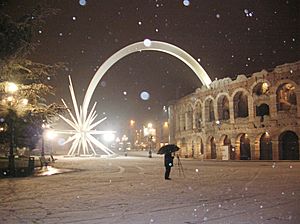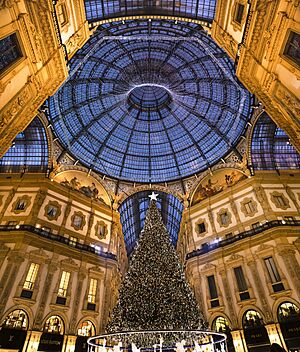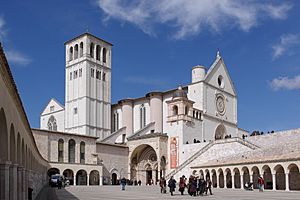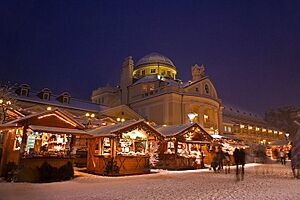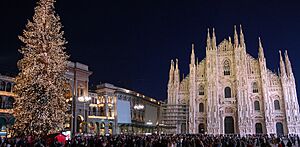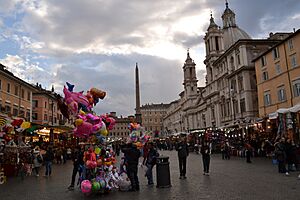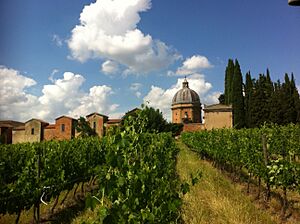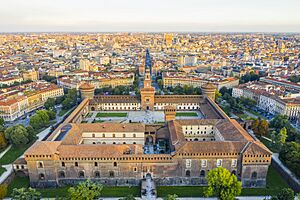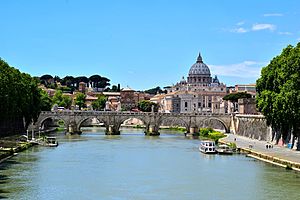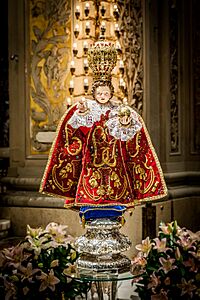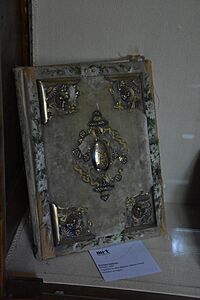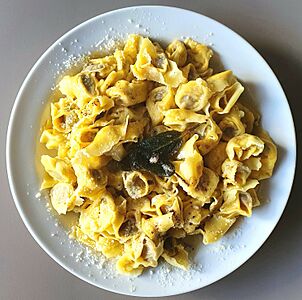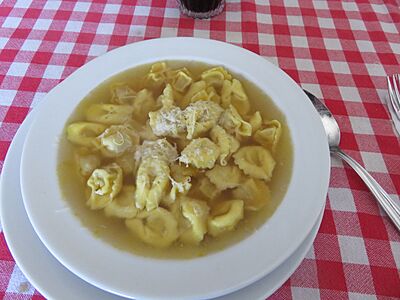Christmas in Italy facts for kids
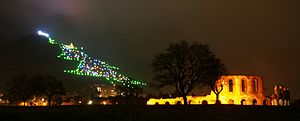
Christmas in Italy (Natale) is a festive season that begins on December 8 and ends on January 6. It starts with the Feast of the Immaculate Conception and finishes with the Epiphany. This period marks the end of the old year and the beginning of a new one.
The Italian word for Christmas is Natale, which comes from the Latin word for "birth". People greet each other by saying Buon Natale (Merry Christmas). Italy has many unique traditions, such as the nativity scene (presepe), which was made popular by Saint Francis of Assisi.
Contents
History of Christmas in Italy
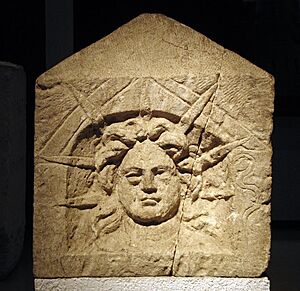
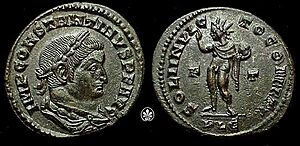
Christianity has a long history in Italy. By the 4th century, people began celebrating the birth of Jesus Christ. The Catholic Church chose December 25 as the date for Christmas. This date matched an ancient Roman festival called Sol Invictus, which celebrated the "Unconquered Sun". This helped people transition from old Roman customs to Christian celebrations.
One of the most famous Italian traditions is the presepe or nativity scene. Saint Francis of Assisi created the first living nativity scene in 1223 in the town of Greccio. He wanted to help people understand the story of Christmas. Today, families and towns across Italy display beautiful nativity scenes. The city of Naples is famous for its very detailed cribs.
Important Dates and Celebrations
The holiday season in Italy includes several important dates:
- December 8: The Feast of the Immaculate Conception. This is a national holiday. Many families put up their decorations and Christmas trees on this day.
- December 25: Christmas Day. Families gather for a large meal.
- December 26: Saint Stephen's Day. This is also a public holiday in Italy. It gives people an extra day to rest and visit family.
- January 6: The Epiphany. This day marks the arrival of the Three Wise Men. It is also when the Befana (a magical old woman) brings gifts to children.
Popular Italian Traditions
Nativity Scene (Presepe)
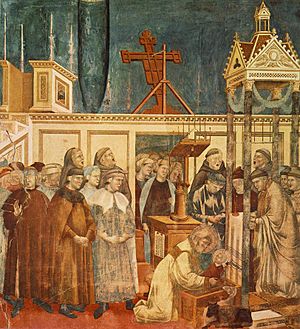
The nativity scene is a very old tradition in Italy. It shows the baby Jesus, Mary, and Joseph in the stable. The first one was created by Saint Francis of Assisi. In Southern Italy, especially in Naples, people make very large scenes. These displays often include shops, animals, and people doing daily jobs, not just the holy family. Some towns have "living nativity scenes" where real people dress up in costumes.
Christmas Tree
The Christmas tree became popular in Italy in the late 1800s. Queen Margherita set up one of the first trees at the Quirinal Palace. Today, almost every home has a tree. The town of Gubbio creates the world's largest Christmas tree by arranging lights on the side of Mount Ingino.
Christmas Markets
Christmas markets are popular in many Italian cities. The oldest one is in Bologna. Markets in the north, like in Bolzano and Trento, are very famous. In Rome, there is a well-known market at Piazza Navona. People buy decorations, sweets, and small gifts at these stalls.
Zampognari (Bagpipers)
In Southern Italy, musicians called zampognari dress as shepherds. They come down from the mountains playing bagpipes called zampogna. They play traditional Christmas music in the streets.
Yule Log
The Yule log is an old tradition, especially in Tuscany and Lombardy. Families would burn a large log in the fireplace. In some areas, children would be blindfolded and hit the log with tongs while singing songs, hoping for sweets.
Gift Bringers
In Italy, different figures bring gifts to children during the season.
Saint Lucy
In some northern cities like Verona and Bergamo, Saint Lucy brings gifts on the night of December 12. Children leave a cup of tea for her and some flour for her donkey.
Babbo Natale
Babbo Natale is the Italian name for Santa Claus. He brings presents on Christmas Eve or Christmas Day. This tradition is now very common all over Italy.
The Befana
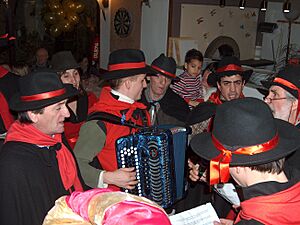
The Befana is a famous Italian character. She looks like an old witch riding a broomstick. On the night of January 5 (Epiphany Eve), she visits houses. She fills stockings with candy for good children and "coal" (made of black sugar) for naughty children. There is a famous rhyme about her wearing broken shoes and a Roman hat.
Regional Festivals
Oh bej! Oh bej!
This is a traditional fair in Milan. It starts on December 7, the day of Saint Ambrose, the city's patron saint. The name means "Oh so nice! Oh so nice!" in the local dialect. It is held near the Sforza Castle and sells sweets, toys, and decorations.
Ndocciata

The Ndocciata is a festival in Agnone, Molise. On Christmas Eve, people carry huge wooden torches in a parade. It looks like a river of fire moving through the streets.
Badalisc
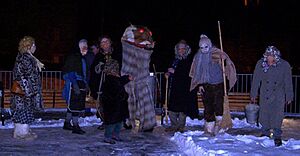
The Badalisc is a mythical creature from the Val Camonica in the Alps. It has a big head and glowing eyes. Every year during Epiphany, people in the village of Andrista have a parade where they "capture" the creature. Someone reads a funny speech where the creature tells jokes about the people in the town.
Traditional Christmas Food
Food is a very important part of Italian Christmas.
Christmas Eve and Day
On Christmas Eve, many families follow the tradition of not eating meat. Instead, they eat fish and vegetables. In Naples, a popular dish is eel (called capitone).
On Christmas Day, families have a big lunch. In Northern Italy, they might eat capon (a type of roasted chicken) or stuffed pasta like agnolini and cappelletti. In Rome, abbacchio (lamb) is a favorite dish.
Sweet Treats
Italy has many famous Christmas cakes and sweets:
- Panettone: A tall, sweet bread with raisins and candied fruit. It comes from Milan.
- Pandoro: A star-shaped cake from Verona. It is usually dusted with powdered sugar to look like snowy mountains.
- Torrone: A nougat made with honey, sugar, egg whites, and nuts. It can be hard or soft.
- Struffoli: Small fried dough balls covered in honey, popular in Naples.
- Panforte: A chewy, spicy cake with fruit and nuts from Siena.
New Year's Eve
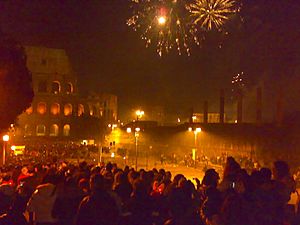
New Year's Eve is called Vigilia di Capodanno. People celebrate with fireworks and big dinners. A traditional dish is cotechino (a type of sausage) served with lentils. Eating lentils is said to bring good luck and money in the new year because they look like little coins. It is also a custom to wear red underwear for good luck!
Tourism and Movies
Many tourists visit Italy during Christmas to see the decorations and markets. Cities like Rome, Milan, and Naples are very popular.
In Italy, there is a genre of comedy movies called Cinepanettone. These funny films are released every Christmas. They usually feature families going on chaotic vacations.
Images for kids
-
Midnight Mass in Santa Severa
-
Confeugo in Genoa
-
Agnolini pasta
-
Cotechino with lentils
See also
- Befana
- Mount Ingino Christmas Tree
- Neapolitan nativity scene
- Public holidays in Italy
- Easter in Italy


